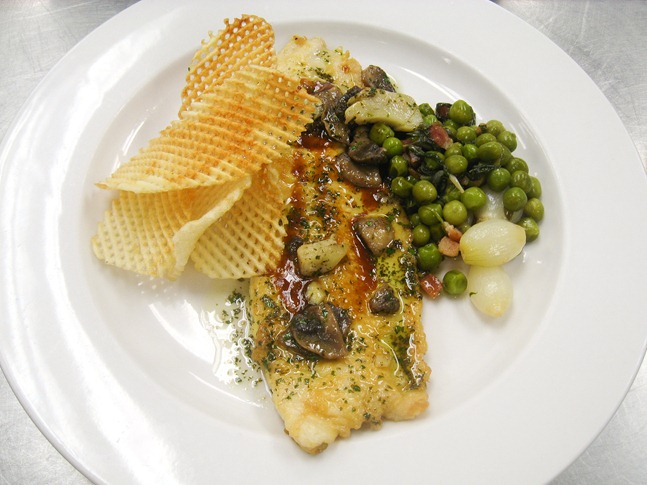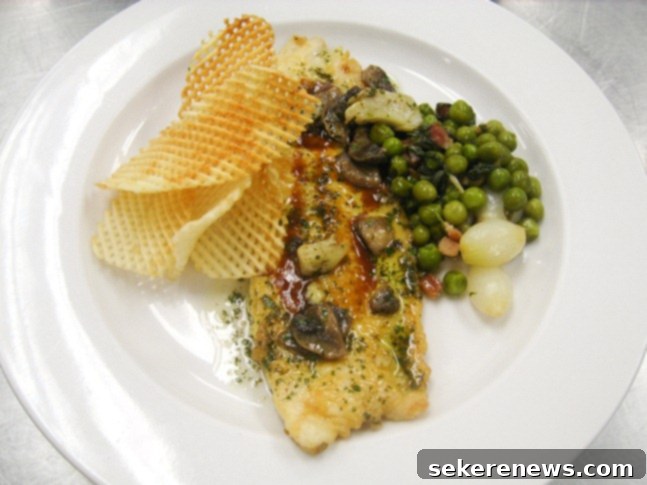Culinary School Chronicles: Mastering French Classics and Navigating a Hectic Week
Life in culinary school is a relentless pursuit of knowledge, skill, and often, sheer endurance. This past week has been no exception, thrusting me from a demanding Saturday stage directly into an even more packed schedule. The upcoming days promise to be an intense juggle of academic rigor and hands-on experience. Not only do I have my fourth theory and practical exam this week, but I’m also volunteering at the prestigious Cochon 555 event on Sunday, and I have another stage opportunity lined up for Monday. Just contemplating the sheer volume of tasks ahead is enough to make me feel utterly drained, yet incredibly motivated.
Given the whirlwind of activities, I’ve decided to hold off on sharing the detailed account of my first culinary stage until next week. To be completely candid, those first several hours were a blur of nervous energy and unexpected challenges. I was immediately given significantly more responsibility than I had anticipated, which initially sent my anxiety soaring. However, every challenge presents an opportunity for growth, and the most rewarding outcome of that demanding night was receiving an offer for an externship at the establishment! This validation, after pushing through initial apprehension, felt incredibly gratifying and reaffirms the exciting, yet demanding, path I’ve chosen in the culinary world.

A Day in the Kitchen: Revisiting Classics and Mastering New Techniques
Despite the external pressures and looming deadlines, our daily menu in the kitchen remains a consistent source of immense learning and delicious creations. Today’s session was particularly insightful, focusing on foundational skills and intricate French techniques. Our first course was a perfectly executed omelet, delicately filled with a rich tomato concassee – a precise mixture of finely diced, seeded, and cooked tomatoes and onions, often seasoned with garlic and fresh herbs. The immediate question among students was, “Why are we reviewing omelets again?” The answer quickly became clear: it was strongly hinted that this seemingly simple dish would be a critical component of our practical exam this week.
Mastering the omelet is a cornerstone of classic French cuisine. It’s far more than just cooking eggs; it’s about precision and finesse that defines culinary excellence. The quintessential trick is to achieve an omelet that gains absolutely no color on the exterior, maintaining a pristine, pale yellow surface. Concurrently, the interior must remain slightly runny and creamy, creating a luxurious texture that melts in the mouth. This delicate balance requires meticulous control over heat, pan movement, and timing, distinguishing a truly professional omelet from a hastily scrambled one. Practicing this seemingly basic dish under the watchful eye of our chefs truly underscores the importance of perfection in culinary fundamentals, preparing us for the rigors of a professional kitchen.
For our main course, we revisited another familiar dish, but with a fresh perspective and new accompaniments: expertly prepared trout filets served with a classic meuniere sauce. Meuniere is a deceptively simple yet elegant sauce, traditionally made by browning butter until it achieves a nutty, amber hue, then emulsifying it with a generous squeeze of fresh lemon juice and vibrant chopped parsley. The art lies in achieving the perfect brown butter without burning it, imparting a deep, rich, yet delicate flavor that complements the subtle taste of fresh fish beautifully. To elevate the dish further and add textural interest, we incorporated perfectly sautéed mushrooms, which added an earthy dimension, and tender, sliced artichoke hearts, contributing a slightly tangy and refined note. This exercise highlighted how subtle variations and thoughtful additions can transform a familiar recipe into something new and exciting, a crucial skill for any aspiring chef aiming for creativity within classic frameworks.

Accompanying the trout, we prepared peas in a rather unique and, dare I say, slightly unconventional manner – at least to my accustomed palate. They were sautéed with strips of smoky bacon, sweet pearl onions, a rich chicken stock, and surprisingly, some shredded lettuce. While the combination might sound unusual, it’s a testament to the diverse and sometimes surprising flavor profiles found in classic French preparations. The bacon, as often is the case, certainly dominated, lending a powerful smoky, savory depth to the peas. I confess, I often find bacon to be an overpowering ingredient, a sentiment that might earn me the culinary equivalent of a leper status among some chefs! Nonetheless, it was an interesting exploration of how different ingredients, even those seemingly at odds, can interact to create a cohesive dish, expanding our understanding of flavor pairings.
Innovative Sides: Crafting Delicate Pommes Gaufrette
Our kitchen session also introduced us to another innovative potato dish that showcases precision and technique: pommes gaufrette. These are essentially elegantly thin, crispy potato chips cut into a distinctive waffle pattern. This preparation is a fantastic demonstration of precision cutting and frying, elevating a simple potato to an art form. To achieve the signature waffle texture, we utilized a mandolin slicer – an indispensable tool in any professional kitchen for uniform slices. The key technique involves making one slice, then rotating the potato exactly 45 degrees before making the next, creating the intricate lattice effect. Once sliced into these delicate wafers, they were carefully fried in oil maintained at a precise 350 degrees Fahrenheit. The result was a delicate, golden-brown chip with an incredibly satisfying crunch and remarkable visual appeal. It’s these small, intricate details that truly elevate a dish and showcase technical skill, and mastering the mandolin for such precise cuts is a rewarding, albeit challenging, endeavor in French culinary arts.

Dessert Delights: The Art of Barquettes – A Classic French Pastry
No true French meal is complete without a sophisticated dessert, and today we tackled the elegant barquettes – small, boat-shaped pastries that are a true testament to classic French patisserie. This confection showcases multiple baking techniques within a single, delightful bite. It begins with a delicate pâte sucrée tart shell, a sweet, crumbly pastry dough that forms the essential base. This meticulously crafted shell is then filled with a rich frangipane, an exquisite almond-flavored pastry cream, and baked until golden brown and wonderfully fragrant. The true artistry, however, comes in the finishing touches. Once the shells have cooled completely, an offset spatula is used to carefully pipe or spread a luscious layer of Italian meringue buttercream on top. This isn’t just any buttercream; it’s a stable, silky, and incredibly smooth meringue-based frosting, intricately flavored with earthy chestnut puree and a hint of warming rum, adding layers of sophisticated flavor and depth to the dessert.
After assembly, the barquettes are refrigerated to allow the buttercream to set firmly, creating a stable foundation for the final step. This final, and arguably trickiest, stage involves dipping each barquette into tempered fondant. It’s crucial to understand that this is not the rolled fondant used for elaborate cake decorating, but a pourable, icing sugar-based glaze designed to provide a pristine, shiny finish. The challenge lies entirely in tempering the fondant correctly – ensuring it’s heated to the perfect temperature and maintained at the ideal consistency. If not executed precisely, the fondant will fail to set properly, resulting in a dull, uneven coating rather than the desired glossy, mirror-like sheen. It’s a dessert that’s difficult to fully appreciate without visual aids, highlighting the visual appeal as much as the taste. But the flavor, despite its inherent sweetness, was a revelation. The complex interplay of almond, chestnut, and rum, balanced by the delicate pastry, created a surprisingly harmonious and utterly delicious treat, far exceeding my initial expectations and demonstrating the subtle complexities of French patisserie.

Afternoon Prep: The Fascinating World of Hand-Crafted Seafood Sausages
Our culinary day extended into the afternoon with an intriguing and rather unique prep session for tomorrow’s menu: hand-making gourmet seafood sausages. This was an entirely new experience for many of us and provided a fascinating insight into charcuterie techniques adapted specifically for delicate seafood. The sausage mixture itself was a luxurious blend, comprising both finely diced, cooked seafood – a gourmet combination of succulent crayfish meat, tender crabmeat, delicate scallops, plump shrimp, and flaky salmon – alongside a delicate seafood mousse. This mousse, made from cream, scallops, and salmon, is essential as it acts as a binder, contributing to the sausage’s smooth, refined texture and ensuring it holds its shape during cooking.

Let me tell you, the process of forming these sausages by hand is truly an interesting spectacle. It involved a level of manual dexterity and, frankly, a somewhat squishy, tactile experience that had us all laughing hysterically by the end. Clearly, our maturity levels were thoroughly tested by the unusual texture and technique! It’s one thing to learn about these processes in theory, but quite another to get your hands dirty and truly understand the nuances of the craft. Chef Patrice, with his characteristic skill, patience, and unwavering precision, demonstrated the technique with practiced ease, showing us how to expertly shape the delicate seafood mixture into perfectly uniform sausages. His effortless movements made the complex task look deceptively simple.

Then, of course, it was our turn. While the process itself might not be the most photogenic – involving a lot of squeezing and shaping of a somewhat unappealing raw mixture – it was an essential and invaluable learning experience, definitely worth documenting. It took a bit of fiddling, some initial awkwardness, and a few false starts, but we gradually got the hang of it, improving with each sausage we managed to form. This direct, hands-on experience is paramount in culinary education, translating theoretical knowledge into tangible, practical skill that will serve us well in any professional kitchen.

After meticulously making and shaping our seafood sausages, the next crucial step was to gently poach them in very hot, but precisely not boiling, water. Poaching is a deliberate and crucial technique here, as it allows the delicate seafood to cook through evenly and gently set its shape without breaking apart, preserving its tender texture and exquisite flavor profile. This foundational step prepares them perfectly for tomorrow’s final preparation. We eagerly anticipate searing them to develop a beautiful, golden-brown crust and serving them alongside freshly made homemade pasta, promising a truly exquisite and memorable dish.

That pretty much encapsulates a day that was equal parts challenging, educational, and undeniably delicious. The journey through culinary school is a relentless pursuit of knowledge and skill, but moments like these, whether mastering a classic omelet, delicately crafting elegant barquettes, or hand-making gourmet seafood sausages, constantly remind me why I embarked on this demanding yet incredibly rewarding path. Now, with the aroma of the kitchen still lingering, I’m off to immerse myself in studying for my upcoming theory exam, preparing for another set of intellectual hurdles. The balance between practical artistry and academic understanding is a continuous tightrope walk, but one I’m determined to navigate with passion and precision.
Until next time, stay hungry for knowledge and delicious food – and wish me luck with those exams!
